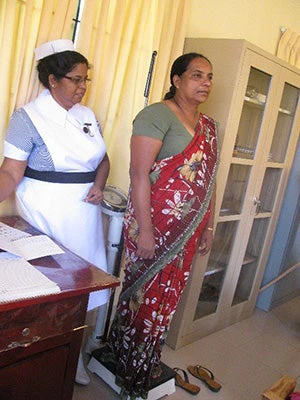
Each time I visit local hospitals in Sri Lanka, my confidence in the public health service is renewed. I see a selfless commitment by both doctors and nursing staff towards their patients, often going beyond their call of duty. I wonder if it is their religious faith of caring for the sick which is considered a meritorious act, that make them go that extra mile.
My visit to the Base Hospital in Horana, in the Kalutara District reinforced this belief. My colleague and I learned first-hand about systems and processes in place to encourage behavioral change to reduce the Non Communicable Disease (NCD) burden that is becoming a silent killer. The fact that seventy percent of the deaths in Sri Lanka are due to NCDs is scary; especially when a sizable portion of the deaths are under sixty five. As the country transitions into a more affluent society, poor food choices and less active lifestyles are exacerbating the situation. Most Chronic NCDs are preventable and if not, its onset can be delayed if risk factors such as smoking, alcohol, chewing beetle leaves, obesity, unhealthy diet, high salt, sugar, trans fats, processed foods and sedentary lifestyles are addressed.

Healthy Lifestyle Centers (HLCs) are newly established, dedicated clinics encouraging preventative care that provides medical advice and screening facilities (not treatment) to men and women who are at high risk category of contracting NCDs. Being in the target group, I listened attentively to the diseases identified as NCDs, including diabetes, cardiovascular diseases, cancer, hypertension and chronic respiratory diseases. The clinic checks blood sugar levels, blood pressure and body mass index (BMI) while providing medical advice against unhealthy food habits, consumption of alcohol and the use of tobacco. The importance of regular exercise is strongly advocated. Where the facilities are available, blood tests are also carried out to assess blood sugar and lipid levels.
While nearly 50 percent of the Medical Officer of Health (MOH) areas in the country are equipped with at least two HLCs with adequate infrastructure, it can be a struggle for HLCs to function at its best due to the lack of dedicated human resources. However, doctors and nurses show their commitment by ensuring that the HLCs functioned at least once a week. It was also heartening to listen to their commitment in reaching out to men, who are often the most resistant to lifestyle advice by putting into practice the adage of ‘taking the mountain to Mohamed’ as a strategy to attract males who don’t believe in coming to the hospitals for screening for risk factors. Visiting factories, taxi stands, offices in the form of mobile HLCs, the healthcare workers were proactive in ensuring that high risk groups were screened.
In addition to providing primary care via the HLCs, we also saw yet another innovative strategy put into motion by mobilizing ‘safe communities’. This concept was predominantly developed to reduce accidents and emergencies which are major contributory factors towards the acute NCD burden. We listened to the passionate explanation of Dr. Kalubowila, the driving force behind this initiative, who emphasized the importance of inter-sectoral coordination that was initiated by this same team of doctors. Dr Kalubowila explained how he managed to bring together key opinion leaders of different social groups who would take the responsibility of making sure that the identified ‘settings’ such as schools, factories, roads, playgrounds etc were turned into safe zones. He further explained how a significant behavioral change has been achieved through continuous counseling and through the concept of social mobilization which has resulted in the reduction of accidents.
The drive, the commitment and the dedication of doctors and healthcare workers will hopefully stem the tide of the NCD burden through Sri Lanka as HLCs are continually rolled out across the country.
To learn more, read the feature story.



Join the Conversation